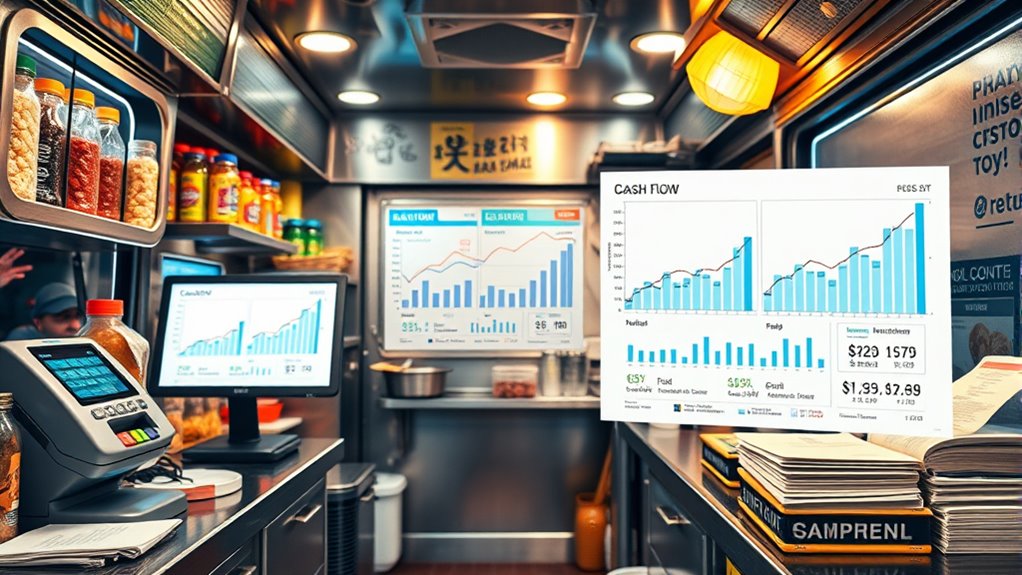To manage cash flow for your food truck, focus on accurate sales forecasting, controlling expenses, and maintaining a cash reserve for slow seasons or emergencies. Track your income and expenses regularly with dashboards and financial reports, and prioritize building a buffer from profits. Adjust your pricing and inventory based on seasonal demand and peak hours to maximize revenue. Following these strategies can help secure your business’s financial health and keep cash flowing smoothly—you’ll find more tips as you explore further.
Key Takeaways
- Monitor daily sales and expenses using POS systems to track cash flow in real-time.
- Build and maintain a cash reserve covering 3-6 months of operating costs for emergencies.
- Create monthly repayment plans aligned with revenue forecasts to manage debt obligations effectively.
- Prioritize consistent cash flow management by regularly reviewing financial reports and adjusting budgets accordingly.
- Implement cost control strategies, such as negotiating bulk deals and menu engineering, to stabilize cash inflows and outflows.
Understanding Food Truck Profit Margins and Cash Flow Basics

Understanding food truck profit margins and cash flow basics is essential for running a successful operation. You’ll find that average profit margins hover around 6.2%, but top performers can reach 14-15%. Compared to brick-and-mortar restaurants, food trucks enjoy higher margins, mainly because of lower startup and labor costs. Your revenue can range from $150,000 to nearly $290,000 annually, with major expenses including food, labor, maintenance, permits, and insurance. To stay profitable, your goal is to cover startup costs quickly and keep monthly revenues above expenses. Managing cash flow involves balancing daily sales against variable costs like ingredients and wages. It’s *vital* to maintain a cash reserve for slow days or unexpected costs, ensuring your truck stays operational and financially healthy. Additionally, understanding food truck profit margins can help you set realistic financial goals and optimize pricing strategies. Approximately 50% of food trucks earn over $150,000 annually, highlighting the industry’s potential for significant earnings when managed effectively.
Developing Accurate Sales Forecasts and Demand Planning Strategies

To develop accurate sales forecasts, you need to analyze your past sales data to identify peak periods and seasonal trends. Adjust your menus accordingly to capitalize on high-demand times and accommodate changing customer preferences. By fine-tuning your demand planning strategies, you can better manage cash flow and optimize inventory. Additionally, estimating the average spend per customer based on market research and customer demographics helps refine sales projections and ensures more reliable financial planning. Understanding the Dad – Amazing Life Together principles can also inspire you to create a welcoming environment that encourages repeat customers.
Analyzing Past Sales Data
Analyzing past sales data is essential for creating accurate sales forecasts and effective demand planning strategies for your food truck. You should calculate the average spend per customer by examining historical transaction data and adjusting for seasonal factors like holidays and weather, which influence purchasing habits. Understanding how menu complexity impacts ticket size helps refine revenue predictions. Additionally, reviewing sales volume trends based on location, day, and time, while considering operational limits, ensures realistic forecasts. Combining average spend with sales volume provides turnover estimates, but always compare these with actual past performance to identify discrepancies. Incorporating location-specific foot traffic and transactional data further sharpens your demand insights. Regularly validating forecasts against capacity constraints helps prevent overestimating sales and supports efficient stock and staffing decisions. Location data analysis can reveal patterns that may significantly influence your sales projections and help optimize your operational planning. For example, understanding how different Honda Tuning upgrades can impact vehicle performance is analogous to how adjusting your sales assumptions can improve forecast accuracy.
Identifying Peak Periods
Have you pinpointed when your food truck experiences its highest customer traffic? Industry data shows that most operators see peak business from 5 PM to 8 PM, with about 63.6% reporting this as their busiest time. Lunchtime, from 11 AM to 2 PM, follows closely, with 55% noting increased sales. Late-night hours, from 11 PM to 2 AM, tend to be slow, only attracting 2-3% of customers. Some locations or seasons cause demand shifts, so about 15% of operators notice variable peak periods. Use past sales data, customer feedback, and local event calendars to identify these busy windows. Focusing your efforts during these peak times guarantees you’re maximizing revenue, reducing waste, and aligning staffing levels with customer demand. Additionally, recognizing the most popular menu items, such as fries, burgers, and BBQ, can help tailor your inventory to meet customer preferences during these busy periods. Incorporating demand planning strategies can further refine your approach, ensuring you’re prepared for fluctuations and optimizing your cash flow.
Adjusting Menus Seasonally
Adjusting your menu seasonally helps align your offerings with ingredient availability and customer preferences, boosting sales and controlling costs. Using fresh, local produce not only enhances flavor but also reduces transportation and storage expenses. Incorporate seasonal items like pumpkins in fall or berries in summer to create unique experiences that attract customers. Analyzing historical sales data by season enables accurate demand forecasting, helping you plan inventory and reduce waste. Monitoring customer feedback and social media insights allows you to adapt menus dynamically, ensuring popular items remain in focus. Introducing limited-time seasonal dishes creates urgency and encourages repeat visits. Collaborate with local suppliers to ensure steady ingredient availability, and plan menu transitions ahead of seasonal shifts to optimize profitability and cash flow. Recognizing the importance of creative practice can further refine your seasonal offerings to meet specific customer needs and preferences, increasing overall satisfaction and sales.
Managing Debt and Maintaining Financial Stability

Effective debt management is essential for maintaining your food truck’s financial stability. You should create a clear, monthly repayment plan aligned with your revenue forecasts to ensure timely loan payments. Continually monitor your cash flow to avoid shortfalls that could jeopardize debt obligations and daily operations. Building an emergency buffer from profits helps cover loan repayments during slow periods. Prioritize debt repayment to protect your credit score and stay eligible for future funding. Use debt repayments as a key financial metric to prevent over-leveraging. Consider tailored financing options like equipment financing or lines of credit to meet specific needs. Regularly update your business plan and track operational costs to manage risks effectively and maintain a healthy financial position. Incorporating cash flow management strategies from the electric bike industry can further optimize your financial health.
Controlling Expenses and Optimizing Cost Efficiency

Controlling expenses and optimizing cost efficiency are crucial for maintaining your food truck’s profitability. Start by sourcing local, seasonal ingredients to cut procurement costs and boost freshness. Negotiating bulk deals with vendors and consolidating deliveries can lead to significant savings. Explore alternative sources like ice vending machines, which can reduce ice costs by up to 50% and save space and energy. Focus on menu engineering by setting ingredient costs at 28-35% of the selling price and designing menu items around high-margin, low-cost ingredients. Implement strict portion controls and monitor sales trends to minimize waste. Monitoring sales data can also help identify which items are most profitable and where adjustments are needed. Optimize labor by scheduling staff during peak hours, cross-training employees, and using technology to speed service. Leveraging partnerships with other local businesses can also help lower costs through shared resources and community support. These strategies help you control expenses and maximize your food truck’s profitability.
Navigating Seasonal and Market Influences on Cash Flow

You need to understand how seasonal demand shifts and increased market competition can challenge your cash flow throughout the year. Adjusting inventory and pricing strategies in response can help you stay profitable during slow periods and capitalize on busy times. Staying proactive about these market influences guarantees you maintain steady cash flow despite fluctuating conditions. Monitoring industry data and metrics enables you to identify trends early and adapt your operations accordingly. Developing skills in market analysis can further improve your ability to anticipate changes and respond effectively.
Seasonal Demand Variability
Seasonal demand fluctuations pose a significant challenge for food truck cash flow, as sales often surge in spring and summer while dipping sharply in colder months. During peak seasons, revenue can increase by 20-30%, but winter brings fewer customers due to weather and fewer outdoor events. To stay afloat, you need to adapt your menu, emphasizing warm, comforting foods in colder months and lighter options in summer. Recognizing the importance of planning ahead can help you prepare for these fluctuations and manage your cash flow more effectively. Consider these strategies:
- Offer seasonal specials to boost interest year-round.
- Build a cash reserve during busy months to cover slow periods.
- Diversify income through catering or online sales to offset seasonal dips.
- Incorporate performance upgrades in your equipment, like better refrigeration or cooking appliances, to improve efficiency and customer satisfaction during all seasons.
Being proactive with planning and menu adjustments ensures smoother cash flow despite demand variability.
Market Competition Impact
Navigating the competitive landscape is essential for maintaining steady cash flow in the food truck industry, especially as market saturation and urban regulations shape operational challenges. With over 58,000 businesses and rising competition, standing out requires strong branding and niche targeting. Urban areas offer growth but come with licensing costs, parking fees, and regulatory hurdles that can disrupt cash flow if not managed carefully. Intense competition for prime locations and food truck events adds pressure to maintain consistent sales. Additionally, rising consumer demand for gourmet, healthy, and customizable options pushes costs higher and demands agility. During economic fluctuations, margins tighten further as ingredients, fuel, and maintenance costs increase, while off-season slowdowns test cash flow resilience. Staying adaptable and strategic in competing environments is crucial for sustained profitability. Understanding types of divorce and the financial implications involved can help food truck owners better plan for unexpected disruptions and protect their cash flow.
Inventory and Pricing Strategies
Effective inventory and pricing strategies are essential for maintaining healthy cash flow in a food truck operation, especially as seasonal and market fluctuations impact costs and customer demand. By adjusting stock levels for seasonal demand, you can avoid overstocking or shortages, minimizing waste and spoilage. Incorporate seasonal produce to reduce costs and attract customers. Use inventory forecasting models that factor in seasonal variables to plan your orders better. Implement dynamic pricing to respond to demand shifts, raising prices during peak seasons and offering discounts during slow periods. Keep an eye on competitor prices and analyze price elasticity to prevent losing loyal customers. Automated inventory tracking systems can provide real-time data to fine-tune your stock levels and pricing strategies effectively.
- Stock minimal perishable items in off-peak seasons to cut waste
- Offer seasonal specials to boost inventory turnover
- Adjust prices based on ingredient availability and demand
Utilizing Cash Flow Planning Tools for Better Financial Oversight

Utilizing cash flow planning tools is essential for maintaining clear financial oversight in your food truck business. These tools, like specialized accounting software, provide real-time inventory tracking, helping you avoid waste and stock shortages. Cloud-based access lets you monitor finances from anywhere, ensuring you stay on top of your cash flow regardless of your location. Financial reports, including profit-and-loss statements and balance sheets, give you a clear picture of your business health. POS systems automate sales reporting, accept multiple payment options, and support offline transactions, keeping your cash flow steady on busy days. Integration between POS, inventory, and accounting software streamlines data entry and forecasting, reducing errors and freeing up your time to focus on growing your food truck. Real-time data updates ensure that your financial information is always current, enabling more accurate decision-making.
Building and Maintaining a Cash Reserve for Emergencies

Building and maintaining a cash reserve is essential for handling unexpected expenses and ensuring your food truck remains financially stable. To do this, define a specific reserve amount based on your business size, cash flow, and seasonal fluctuations. Regularly review and adjust your reserve policy so it reflects current conditions. Aim to hold enough cash to cover 3-6 months of operating expenses, accounting for equipment failures or supply chain issues. Keep your emergency funds in highly liquid accounts like checking or money market accounts for immediate access. Diversify your reserves to protect against risks and monitor them regularly, replenishing after use. Researching industry standards can help you set realistic reserve targets that align with common practices. Create formal guidelines for accessing reserves to prevent misuse. Prioritize reducing discretionary expenses to boost savings. Use sales forecasts to refine reserve levels and avoid over-reserving.
Monitoring Financial Performance With Dashboards and Reports

Maintaining a solid cash reserve is essential, but it’s equally important to regularly track and analyze your financial performance to guarantee your food truck stays on course. Dashboards and reports give you a visual overview of key metrics like revenue, expenses, and cash flow status, enabling quick assessments. Real-time data helps you spot trends and make strategic decisions promptly. You can customize dashboards to focus on sales channels, operating hours, and seasonality, improving accuracy. Use KPIs such as average check size, food cost percentage, and gross profit margin to gauge profitability. Reporting metrics like sales volume, break-even point, and revenue segmentation provide a comprehensive view of operational health. Here’s a quick snapshot:
| Metric | Purpose | Frequency |
|---|---|---|
| Sales Volume | Revenue tracking | Weekly |
| Break-Even Analysis | Cost coverage assessment | Monthly |
| Revenue Segmentation | Identifies peak revenue sources | Quarterly |
Implementing Strategies to Maximize Revenue During Peak Seasons

How can you maximize your food truck’s revenue during peak seasons? Focus on optimizing your menu by highlighting high-demand, easy-to-prepare items to speed up service. Remove slow-selling dishes to streamline operations and introduce seasonal specials to attract more customers. Promote combo meals and value deals to boost the average order size, and adjust menu prices to reflect higher demand for increased profitability. Revenue often increases significantly during peak seasons, making strategic menu adjustments crucial. Stock up on key ingredients in bulk and prepare them in advance to prevent shortages. Book prime spots at festivals, markets, and community events, and partner with local businesses for cross-promotions. Ramp up social media with enticing photos, limited-time offers, and online ordering to attract more customers and reduce wait times.
Frequently Asked Questions
How Can I Improve Cash Flow Predictability for My Food Truck?
You can improve cash flow predictability by regularly updating your financial tracking systems, including profit and loss statements and cash flow forecasts. Use real-time dashboards to monitor key metrics and analyze sales trends, adjusting inventory and staffing accordingly. Build a cash reserve for emergencies, control costs by negotiating with suppliers, and plan for seasonal fluctuations. Staying disciplined in recording expenses and projecting revenue helps you anticipate cash needs and avoid surprises.
What Are the Best Practices for Managing Seasonal Cash Flow Fluctuations?
To manage seasonal cash flow fluctuations effectively, you should develop realistic monthly projections based on past data and seasonal trends. Keep an eye on income and expenses during peak and off-peak times, adjusting your budgets accordingly. Build a cash reserve during busy seasons, and explore diversifying your revenue streams like catering or merchandise. Use financing options and technology tools to stay flexible, ensuring your business remains stable year-round.
How Do I Balance Inventory Costs With Cash Flow Needs Effectively?
Balancing inventory costs with cash flow needs requires careful planning. You should track your inventory turnover to prevent overstocking or stockouts, and forecast sales accurately to align purchases with demand. Stick to strict budgets for inventory and keep a cash reserve for surprises. Regularly monitor cash flow, prioritize high-margin items, and adjust menu offerings seasonally. This way, you maintain healthy cash flow without tying up too much capital in inventory.
What Strategies Help Reduce Food Truck Operating Costs Without Sacrificing Quality?
To trim operating costs without compromising quality, you can streamline your menu to focus on popular, cost-effective items, limiting waste and ingredient diversity. Sourcing seasonally and locally helps lower expenses while maintaining freshness. Employing energy-efficient equipment and planning routes smartly reduces fuel costs. Cross-training staff and automating routine tasks cut labor expenses. Additionally, negotiating with suppliers and choosing strategic locations can further enhance your financial efficiency without sacrificing customer experience.
How Can Technology Streamline Cash Flow Management for Food Truck Businesses?
Technology can make managing your cash flow easier by automating transactions and tracking sales in real-time. You can integrate POS systems with accounting software, reducing manual errors and saving time. Cloud-based platforms give you instant access to financial data, helping you analyze performance and make quick decisions. Inventory and expense management tools prevent overspending and stock issues, while digital financing options guarantee you can handle cash flow fluctuations smoothly.
Conclusion
Mastering cash flow management keeps your food truck running smoothly, like a well-oiled machine. By understanding your profit margins, planning ahead, controlling expenses, and preparing for seasonal shifts, you’ll turn financial challenges into opportunities. Think of cash flow as the heartbeat of your business—keep it steady, and your food truck will thrive even when the market pulses unpredictably. Stay vigilant, adapt quickly, and watch your success grow like a flourishing garden.









